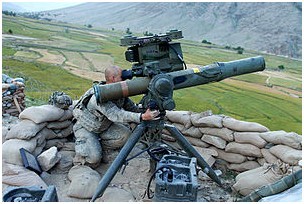
BGM-71 TOW
USINFO | 2013-12-17 17:19
The BGM-71 TOW ("Tube-launched, Optically-tracked, Wire-guided") is an anti-tank missile. First produced in 1970, the TOW is one of the most widely used anti-tank guided missiles.
Design and development
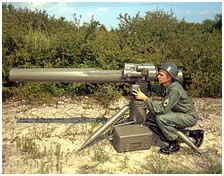
A U.S. Army soldier in 1964, with the first concept mock-up of Redstone Arsenal's purposed future HAW system (Heavy Antitank Weapon). The HAW ultimately resulted in the modern-day TOW.
Initially developed by Hughes Aircraft between 1963 and 1968, the XBGM-71A was designed for both ground and heli-borne applications. In 1997, Raytheon Co. purchased Hughes Electronics from General Motors Corporation, so development and production of TOW systems now comes under the Raytheon brand. The BGM-71 TOW wire-guided heavy anti-tank missile is produced by Raytheon Systems Company. The weapon is used in anti-armor, anti-bunker, anti-fortification and anti-amphibious landing roles. The TOW is in service with over 45 militaries and is integrated on over 15,000 ground, vehicle and helicopter platforms worldwide.
In its basic infantry form, the system comprises a missile in a sealed tube which is clipped to a launch tube prior to use. When required, the missile tube is attached to the rear of the launch tube, the target sighted and the missile fired. The launch motor (booster) fires through lateral nozzles amidships and propels the missile from the tube, at which point four wings indexed at 45 degrees just forward of the booster nozzles spring open forwards, four tail control surfaces flip open rearwards, and sustained propulsion is subsequently provided by the flight motor. An optical sensor on the sight continuously monitors the position of a light source on the missile relative to the line-of-sight, and then corrects the trajectory of the missile by generating electrical signals that are passed down two wires to command the control surface actuators.
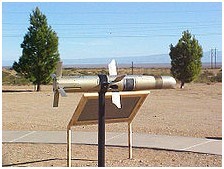
A TOW missile on display at the White Sands Missile Range Museum.
The TOW missile was continually upgraded, with an improved TOW missile (ITOW) appearing in 1978 that had a new warhead triggered by a long probe, which was extended after launch, that gave a stand-off distance of 15 in (380 mm) for improved armor penetration. The 1983 TOW 2 featured a larger 5.9 kg (13 lb) warhead with a 21.25 in (540 mm) extensible probe, improved guidance and a motor that provided around 30% more thrust.[4] This was followed by the TOW 2A/B which appeared in 1987.
Hughes developed a TOW missile with a wireless data link in 1989, referred to as TOW-2N, but this weapon was not adopted for use by the U.S. military. [Raytheon] continued to develop improvements to the TOW line, but its FOTT (Follow-On To TOW) program was canceled in 1998, and its TOW-FF (TOW-Fire and Forget) program was cut short on 30 November 2001 because of funding limitations.[5] In 2001 and 2002, Raytheon and the U.S. Army worked together on an extended range TOW 2B variant, initially referred to as TOW-2B (ER), but now called TOW-2B Aero which has a special nose cap that increases range to 4500 meters. Although this missile has been in production since 2004, no U.S. Army designation has yet been assigned. Also, a wireless version of the TOW-2B Aero was developed that uses stealth one way radio link, called TOW-2B Aero RF.
The TOW missile in its current variations is not a fire-and-forget weapon, and like most second generation wire-guided missiles has Semi-Automatic Command Line of Sight guidance. This means that the guidance system is directly linked to the platform, and requires that the target be kept in the shooter's line of sight until the missile impacts. This has been the major impetus to develop either a fire-and-forget version of the system or to develop a successor with this ability.
In October 2012, Raytheon received a contract to produce 6,676 TOW (wireless-guided) missiles for the U.S. military. Missiles that will be produced include the BGM-71E TOW 2A, the BGM-71F TOW 2B, the TOW 2B Aero, and the BGM-71H TOW Bunker Buster. By 2013, the U.S. Marine Corps had retired the air-launched TOW missile.
Launch platforms
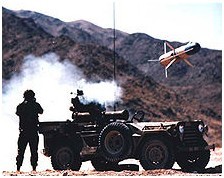
A TOW missile being fired from anM151 MUTT.
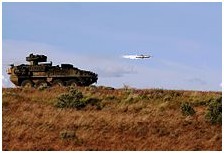
A U.S. Army M1134 Stryker ATGM carrier at the Yakima Training Center fires a TOW missile in May 2011.
The TOW is designated as a BGM by the U.S. military: a multiple launch environment (B) surface attack (G) guided missile (M). The B launch environment prefix is used only when the system can be used essentially unmodified when launched from a variety of launch platforms.
The M151 and M220 launchers are used by infantry, but can also be mounted on a number of vehicles, including the M151jeep, the M113 APC, the M966 HMMWV and the M1045 HMMWV (which replaced the M966). These launchers are theoretically man-portable, but are quite bulky. The updated M151 launcher was upgraded to include thermal optics to allow night time usage, and had been simplified to reduce weight. The M220 was specifically developed to handle the TOW-2 series.
TOW systems have also been developed for vehicle specific applications on the M2/M3 Bradley IFV/CFV, the LAV-AT, the M1134 Stryker ATGM carrier, and the now obsolete M901 ITV (Improved TOW Vehicle); they are generally referred to as TOW Under Armor (TUA).
In helicopter applications, the M65 system used by the AH-1 series is the primary system deployed, but the XM26 system was developed for the UH-1, and a system was put into development for the later canceled AH-56 helicopter.
The M41 TOW improved target acquisition system (ITAS) is a block upgrade to the M220 ground/high-mobility multipurpose wheeled vehicle (HMMWV)-mounted TOW 2 missile system. The TOW ITAS is currently being fielded to airborne, air assault, and light infantry forces throughout the active and reserve components of the U.S. Army and U.S. Marine Corps where it is called the SABER. The ITAS, in addition to providing better anti-armor capabilities to antitank units, also has capabilities that make it an integral part of the combined arms team. Even when organized in heavy—light task forces, where the preponderance of antiarmor capabilities traditionally has resided in the heavy elements, TOW ITAS-equipped antitank units can not only destroy threat targets but also provide superior reconnaissance, surveillance, and target acquisition (RSTA), rear area protection, and urban operations capabilities.
The TOW ITAS consists of three new line replaceable units: the target acquisition subsystem (TAS), the fire control subsystem (FCS), and the lithium battery box (LBB); a modified TOW 2 traversing unit; the existing TOW launch tube and tripod; and a TOW Humvee modification kit. The TAS integrates into a single housing the direct view optics, a second-generation forward looking infrared (FLIR) night vision sight (NVS), missile trackers, and a laser range finder. TAS electronics provide automatic boresighting for these components, eliminating both tactical collimation and 180-day verification requirements.
Service history
Vietnam: first combat use of TOW anti-armor missile
On 24 April 1972, the U.S. 1st Combat Aerial TOW Team arrived in South Vietnam; the team's mission was to test the new anti-armor missile under combat conditions. The team consisted of three crews, technical representatives from Bell Helicopter and Hughes Aircraft, members of the United States Army Aviation and Missile Command, and two UH-1B helicopters; each mounting the XM26 TOW weapons system, which had been taken from storage. After displacing to the Central Highlands for aerial gunnery, the unit commenced daily searches for enemy armor. On 2 May 1972, U.S. Army UH-1 Huey helicopters firing TOWs destroyed North Vietnamese tanks near An Loc. This was heralded as the first time a U.S. unit neutralized enemy armor using American-designed and built guided missiles(in this case against an American-made M-41). On 9 May, elements of the North Vietnamese Army's 203rd Armored Regiment assaulted a camp at Ben Het held by Army of the Republic of Vietnam Rangers . The Rangers destroyed the first three PT-76 amphibious light tanks of the 203rd, thereby breaking up the attack. During the battle for the city of Kontum, the TOW missile had proven to be a significant weapon in disrupting enemy tank attacks within the region. By the end of May, BGM-71 TOW missiles had accumulated 24 confirmed kills of both PT-76 light and T-54 main battle tanks. 1976 saw the introduction of AH-1 Attack Helicopters equipped with TOW guided missiles.
On 19 August, the South Vietnamese 5th Infantry Regiment abandoned Base Camp Ross in the Que Son Valley, 30 miles southwest of Da Nang, to the North Vietnamese 711th Division. A dozen TOW missiles were left with abandoned equipment and fell into Communist hands.
1982 Lebanon War
The Israel Defense Forces have used TOW missiles during the 1982 Lebanon War. On 11 July an Israeli anti-tank squad armed with the TOW ambushed Syrian armored forces and destroyed 11 SyrianSoviet-made T-72 tanks. This was probably the first encounter of the American anti-tank missile with the newest Soviet tank.
Other service
The TOW was used effectively during multiple engagements during Operation Desert Storm. Several TOW missiles were used by U.S. forces in Iraq in the 22 July 2003 assault that killed UdayHusseinand Qusay Hussein.
Variants
| Designation | Description | Length | Diameter | Wingspan | Launch weight | Warhead | Armor penetration (est.) | Range | Speed[citation needed] |
| XBGM-71A/BGM-71A | Hughes Tube launched Optically tracked Wire command link guided (TOW) Missile | 1.16 m | 0.152 m | 0.46 m | 18.9 kg | 3.9 kg (2.4 kg HE) HEAT | 430 mm (exact value) | 65–3,750 m | 278 m/s |
| BGM-71B | BGM-71A variant; improved range | ||||||||
| BGM-71C | BGM-71B variant; Improved TOW (ITOW) w/ improved shaped-charge warhead |
1.41 m (probe extended) 1.17 m (probe folded) |
19.1 kg | 630 mm (exact value) | |||||
| BGM-71D | BGM-71C variant; TOW-2, improved guidance, motor and enlarged main warhead |
1.51 m (probe extended) 1.17 m (probe folded) |
21.5 kg |
5.9 kg (3.1 kg HE) HEAT |
900 mm | ||||
| BGM-71E | BGM-71D variant; TOW-2A optimized to defeat reactive armor with tandem warheads | 22.6 kg |
900 mm (behind ERA) (and layer of ERA) |
||||||
| BGM-71F | BGM-71D variant; TOW-2B top-down attack variant using explosively formed penetrators | 1.168 m | 6.14 kg HEAT[15] | no data | 65-4,200 m[N 1][16] | ||||
| BGM-71G | BGM-71F variant; different AP warhead; not produced | no data | no data | no data | no data | 65–3,750 m | |||
| BGM-71H | BGM-71E variant; "bunker buster" variant for use against fortified structures | no data | no data | no data | no data |
Original armor penetration estimates were 600 mm for BGM-71A/B and 700–800 mm for BGM-71C. However, according to a now declassified CIA study "U.S. INTELLIGENCE AND SOVIET ARMOR" written by Paul F. Gorman (Major General, USA), the true penetration values against a vertical target are much lower—just 430 mm for basic TOW and 630 mm for Improved TOW (see graph US ATGMs vs. Soviet Tank on page 18 of mentioned document, available through Freedom of Information Act).
Time to target at maximum range is 20 seconds therefore giving an average speed of 187.5 m/s.
International variants
Iran has reverse engineered and currently manufactures duplicate TOW missiles. These carry the Iranian designation of Toophan.
Operators
Iran has reverse engineered and currently manufactures duplicate TOW missiles. These carry the Iranian designation of Toophan.
Operators
|
|
|
Share this page


